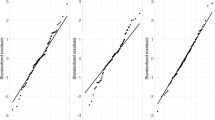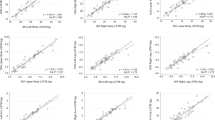Abstract
The purpose of the present study was to determine the validity of various laboratory methods for estimating percent body fat (%fat) in NCAA Division I college female athletes (n = 29; 20 ± 1 year). Body composition was assessed via hydrostatic weighing (HW), air displacement plethysmography (ADP), and dual-energy X-ray absorptiometry (DXA), and estimates of %fat derived using 4-compartment (C), 3C, and 2C models were compared to a criterion 5C model that included bone mineral content, body volume (BV), total body water, and soft tissue mineral. The Wang-4C and the Siri-3C models produced nearly identical values compared to the 5C model (r > 0.99, total error (TE) < 0.40%fat). For the remaining laboratory methods, constant error values (CE) ranged from −0.04%fat (HW-Siri) to −3.71%fat (DXA); r values ranged from 0.89 (ADP-Siri, ADP-Brozek) to 0.93 (DXA); standard error of estimate values ranged from 1.78%fat (DXA) to 2.19%fat (ADP-Siri, ADP-Brozek); and TE values ranged from 2.22%fat (HW-Brozek) to 4.90%fat (DXA). The limits of agreement for DXA (−10.10 to 2.68%fat) were the largest with a significant trend of −0.43 (P < 0.05). With the exception of DXA, all of the equations resulted in acceptable TE values (<3.08%fat). However, the results for individual estimates of %fat using the Brozek equation indicated that the 2C models that derived BV from ADP and HW overestimated (5.38, 3.65%) and underestimated (5.19, 4.88%) %fat, respectively. The acceptable TE values for both HW and ADP suggest that these methods are valid for estimating %fat in college female athletes; however, the Wang-4C and Siri-3C models should be used to identify individual estimates of %fat in this population.




Similar content being viewed by others
References
Arngrimsson S, Evans EM, Saunders MJ, Ogburn CL, Lewis RD, Cureton KJ (2000) Validation of body composition estimates in male and female distance runners using estimates from a four-component model. Am J Hum Biol 12:301–314. doi:10.1002/(SICI)1520-6300(200005/06)12:3<301::AID-AJHB1>3.0.CO;2-J
Ballard TP, Fafara L, Vukovich MD (2004) Comparison of BOD POD and DXA in female collegiate athletes. Med Sci Sports Exerc 36:731–735. doi:10.1249/01.MSS.0000121943.02489.2B
Baumgartner RN, Heymsfield SB, Lichtman S, Wang J, Pierson RN Jr (1991) Body composition in elderly people: effect of criterion estimates on predictive equations. Am J Clin Nutr 53:1345–1353
Bland JM, Altman DG (1986) Statistical methods for assessing agreement between two methods of clinical measurement. Lancet 1:307–310
Brozek J, Grande F, Anderson JT, Keys A (1963) Densitometric analysis of body composition: revision of some quantitative assumptions. Ann N Y Acad Sci 110:113–140. doi:10.1111/j.1749-6632.1963.tb17079.x
Bunt JC, Lohman TG, Boileau RA (1989) Impact of total body water fluctuations on estimation of body fat from body density. Med Sci Sports Exerc 21:96–100. doi:10.1249/00005768-198902000-00017
Clasey JL, Kanaley JA, Wideman L, Heymsfield SB, Teates CD, Gutgesell ME, Thorner MO, Hartman ML, Weltman A (1999) Validity of methods of body composition assessment in young and older men and women. J Appl Physiol 86:1728–1738
Economos CD, Nelson ME, Fiatarone MA, Dallal GE, Heymsfield SB, Wang J, Yasumara S, Ma R, Vaswani AN, Russell-Aulet M, Pierson RN (1997) A multi-center comparison of dual energy X-ray absorptiometers: in vivo and in vitro soft tissue measurement. Eur J Clin Nutr 51:312–317. doi:10.1038/sj.ejcn.1600400
Ellis KJ (2000) Human body composition: in vivo methods. Physiol Rev 80:649–680
Fahey TD, Akka L, Rolph R (1975) Body composition and VO2 max of exceptional weight-trained athletes. J Appl Physiol 39:559–561
Fields DA, Wilson GD, Gladden LB, Hunter GR, Pascoe DD, Goran MI (2001) Comparison of the BOD POD with the four-compartment model in adult females. Med Sci Sports Exerc 33:1605–1610. doi:10.1097/00005768-200109000-00026
Friedl KE, DeLuca JP, Marchitelli LJ, Vogel JA (1992) Reliability of body-fat estimations from a four-compartment model by using density, body water, and bone mineral measurements. Am J Clin Nutr 55:764–770
Genton L, Hans D, Kyle UG, Pichard C (2002) Dual-energy X-ray absorptiometry and body composition: differences between devices and comparison with reference methods. Nutrition (Burbank. Los Angeles Cty Calif 18:66–70
Heymsfield SB, Wang J, Heshka S, Kehayias JJ, Pierson RN (1989) Dual-photon absorptiometry: comparison of bone mineral and soft tissue mass measurements in vivo with established methods. Am J Clin Nutr 49:1283–1289
Heymsfield SB, Lohman TG, Wang Z, Going SB (1996) Multicomponent molecular level models of body composition analysis. In: Roche AF, Heymsfield SB, Lohman TG (eds) Human body composition. Human Kinetics, Champaign, pp 129–148
Heyward VH, Wagner DR (2004) Applied Body Composition Assessments. Human Kinetics, Champaign
Keppel G, Wickens TD (2004) Design and Analysis: A Researchers Handbook. Prentice Hall, Upper Saddle River
Lohman TG (1986) Applicability of body composition techniques and constants for children and youths. Exerc Sport Sci Rev 14:325–357. doi:10.1249/00003677-198600140-00014
Lohman TG, Harris M, Teixeira PJ, Weiss L (2000) Assessing body composition and changes in body composition. Another look at dual-energy X-ray absorptiometry. Ann N Y Acad Sci 904:45–54
Matthie J, Zarowitz B, De Lorenzo A, Andreoli A, Katzarski K, Pan G, Withers P (1998) Analytic assessment of the various bioimpedance methods used to estimate body water. J Appl Physiol 84:1801–1816
Minderico CS, Silva AM, Keller K, Branco TL, Martins SS, Palmeira AL, Barata JT, Carnero EA, Rocha PM, Teixeira PJ, Sardinha LB (2007) Usefulness of different techniques for measuring body composition changes during weight loss in overweight and obese women. Br J Nutr 1–10
Moon JR, Hull HR, Tobkin SE, Teramoto M, Karabulut M, Roberts MD, Ryan ED, Kim SJ, Dalbo VJ, Walter AA, Smith AE, Cramer JT, Stout JR (2007) Percent body fat estimations in college women using field and laboratory methods: a three-compartment model approach. J Int Soc Sports Nutr 4:16. doi:10.1186/1550-2783-4-16
Moon JR, Tobkin SE, Roberts MD, Dalbo VJ, Kerksick CM, Bemben MG, Cramer JT, Stout JR (2008) Total body water estimations in healthy men and women using bioimpedance spectroscopy: A deuterium oxide comparison. Nutr Metab (Lond) 5:7. doi:10.1186/1743-7075-5-7
Oldroyd B, Smith AH, Truscott JG (2003) Cross-calibration of GE/Lunar pencil and fan-beam dual energy densitometers–bone mineral density and body composition studies. Eur J Clin Nutr 57:977–987. doi:10.1038/sj.ejcn.1601633
Prior BM, Modlesky CM, Evans EM, Sloniger MA, Saunders MJ, Lewis RD, Cureton KJ (2001) Muscularity and the density of the fat-free mass in athletes. J Appl Physiol 90:1523–1531
Sardinha LB, Silva AM, Teixeira PJ (2003) Usefulness of age-adjusted equations to estimate body fat with air displacement Plethysmography in male adolescent athletes. Acta Diabetol 40:51–55. doi:10.1007/s00592-003-0026-x
Silva AM, Minderico CS, Teixeira PJ, Pietrobelli A, Sardinha LB (2006) Body fat measurement in adolescent athletes: multicompartment molecular model comparison. Eur J Clin Nutr 60:955–964. doi:10.1038/sj.ejcn.1602405
Siri WE (1961) Body composition from fluid spaces and density. Analysis of methods. In: Brozek J, Henschel A (eds) Techniques for Measuring Body Composition. National Academy of Sciences, Washington, DC, pp 223–244
Tylavsky F, Lohman T, Blunt BA, Schoeller DA, Fuerst T, Cauley JA, Nevitt MC, Visser M, Harris TB (2003) QDR 4500A DXA overestimates fat-free mass compared with criterion methods. J Appl Physiol 94:959–965
Van Der Ploeg GE, Withers RT, Laforgia J (2003) Percent body fat via DEXA: comparison with a four-compartment model. J Appl Physiol 94:499–506
Van Loan MD, Withers P, Matthie J, Mayclin PL (1993) Use of bioimpedance spectroscopy to determine extracellular fluid, intracellular fluid, total body water, and fat-free mass. Basic Life Sci 60:67–70
Vescovi JD, Hildebrandt L, Miller W, Hammer R, Spiller A (2002) Evaluation of the BOD POD for estimating percent fat in female college athletes. J Strength Cond Res 16:599–605. doi:10.1519/1533-4287(2002)016<0599:EOTBPF>2.0.CO;2
Wang ZM, Deurenberg P, Guo SS, Pietrobelli A, Wang J, Pierson RN Jr, Heymsfield SB (1998) Six-compartment body composition model: inter-method comparisons of total body fat measurement. Int J Obes Relat Metab Disord 22:329–337. doi:10.1038/sj.ijo.0800590
Wang Z, Pi-Sunyer FX, Kotler DP, Wielopolski L, Withers RT, Pierson RN Jr, Heymsfield SB (2002) Multicomponent methods: evaluation of new and traditional soft tissue mineral models by in vivo neutron activation analysis. Am J Clin Nutr 76:968–974
Wang Z, Shen W, Withers RT, Heymsfield SB (2005) Multicomponent molecular-level models of body composition analysis. In: Heymsfield SB, Lohman TG, Wang Z, Going SB (eds) Human body composition. Human Kinetics, Champaign, pp 163–176
Williams JE, Wells JC, Wilson CM, Haroun D, Lucas A, Fewtrell MS (2006) Evaluation of Lunar Prodigy dual-energy X-ray absorptiometry for assessing body composition in healthy persons and patients by comparison with the criterion 4-component model. Am J Clin Nutr 83:1047–1054
Wilmore JH, Vodak PA, Parr RB, Girandola RN, Billing JE (1980) Further simplification of a method for determination of residual lung volume. Med Sci Sports Exerc 12:216–218
Withers RT, LaForgia J, Pillans RK, Shipp NJ, Chatterton BE, Schultz CG, Leaney F (1998) Comparisons of two-, three-, and four-compartment models of body composition analysis in men and women. J Appl Physiol 85:238–245
Acknowledgments
We would like to thank all of the athletes who participated in this investigation and Vincent J. Dalbo for his efforts during data collection. Additionally, we would like to thank Sarah Cahill for her dedication and support as a strength coach.
Author information
Authors and Affiliations
Corresponding author
Rights and permissions
About this article
Cite this article
Moon, J.R., Eckerson, J.M., Tobkin, S.E. et al. Estimating body fat in NCAA Division I female athletes: a five-compartment model validation of laboratory methods. Eur J Appl Physiol 105, 119–130 (2009). https://doi.org/10.1007/s00421-008-0881-9
Accepted:
Published:
Issue Date:
DOI: https://doi.org/10.1007/s00421-008-0881-9




